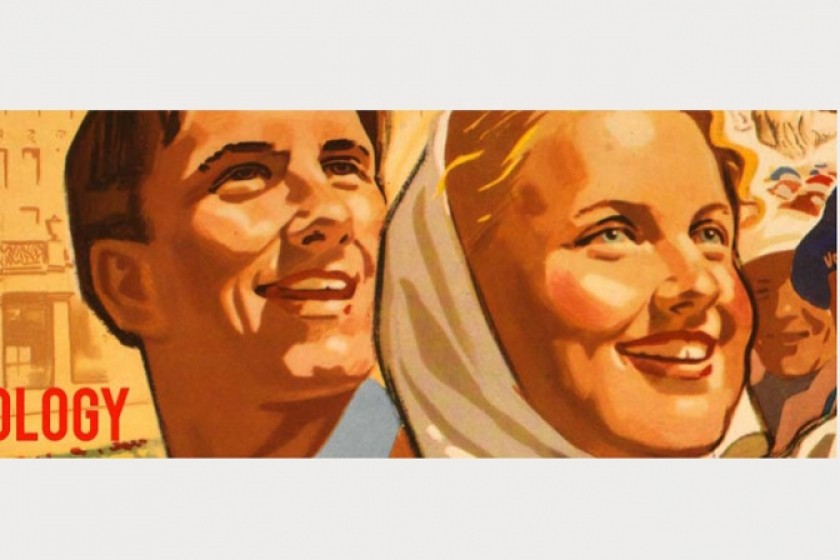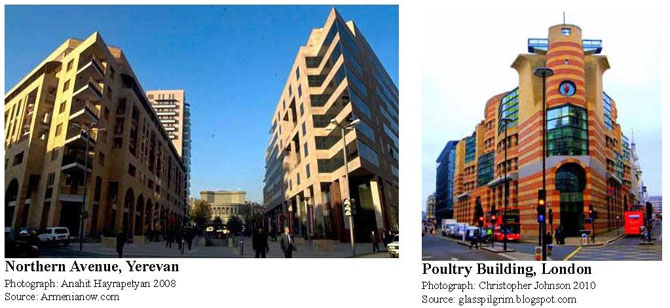
Power of Ideology in the Urban Landscape
By Vrej Haroutounian
In theory, postmodern culture suggests the possibility of reconciling landscape and vernacular, and market and place; but the more visible it becomes, the more it takes on the decontextualized, market-oriented look of franchise culture. Postmodern architecture then makes places less distinctive. They become ‘nonplaces’ in the global markets
Sharon Zukin
The city is a very powerful product of modern society and its performance has an immediate impact on its citizens. Further, a city in the process of construction requires a large investment of human labor and construction materials, which have a lifespan dependent on construction quality and ideology-motivated design principles.
The construction of space creates a sense of place and, in the case of the urban landscape, this is uniquely defined by the political, cultural, and social ideologies that are pervasive at the time. Lefebvre argues that space is a social product, and the production of spaceis directly correlated to the social interaction of citizens that live within the space: “Modern urban space is a reflection of the dominant modes of production today” (Lefebvre, 1991, p.46)
“There are different perspectives on the function of the city. Some perceive the urban landscape as a market, while to others it is home. The market is both a physical place and a symbolic space, as shown in the towns and cities of Europe, which have historically had distinct characters that included markets and their definable borders.” (Zukin, 1991)
“Cities, as unique places, exist as unique expressions of a particular culture. Their individual characters relate to the social distances that exist in betweencities. Modern advancements in communication and transportation technologies decrease the social distance between places, in turn diminishing the concept of place, as markets become more and more globalized.” (Zukin, 1991)
“We are used to thinking of place as a geographical location, a point on a well-bounded map. Place on that level indeed refers to territory- a territory with its own flora and fauna and local allegiances. Closely related is the idea of specific places as concentration of people and economic activity. Place in this sense is form of local society rendered so special by economic and demography that it instantly conjures up an instant image: Detroit, Chicago, Manhattan, Miami. Place in a third, broader sense is a cultural artifact of social conflict and cohesion” (Zukin, 1991, p. 12).
“The image of the urban landscape is inclusive of both its physical form and the social, cultural, political and ecological activities that animate and provide it with its unique sense of place.” (Lefebvre, 1991)
“Control over the image of a place is a powerful tool in shaping how the observer views their role in the place. The changing of a place’s image solves the problems of surplus capital and labor. In the process of redesigning Paris in the early twentieth century, Georges-Eugene Haussmann drew upon utopian designs and the Keynesian system of debt-financed, infrastructural, urban improvements to develop a concept of what the new urban landscape of Paris should look like. Through massive construction projects, the new cityscape boasted 120-meter wide boulevards and lighted avenues. This new image promoted new ideals, replacing a politically-motivated cityscape with one that was economically and socially-centered. In the process of developing a new image for the city, the concept of place that existed in the minds of its inhabitants was, for the most part, destroyed. Paris became the great city of consumerism, tourism and travel. It became a city which could absorb even greater amounts of the surplus capital it attracted from tourists and locals that enjoyed its cafes and department stores. However, the speculative financial system of credits crashed eventually, leading to a complete shift in political power.” (Harvey, 2012)
The Paris that Haussmann built was for the citizens who could afford to live in it, in accordance with the rules of the new city. The people who could no longer afford the cost of living in the new city were pushed out.
“The Paris created by Haussmann is predominantly the image of Paris that remains in the minds of people today.” (Harvey, 2012)
“The massive material and labor investments that were made in the architecture and urban landscape of Paris during that time have defined the universal identity of the city. Hence, once a city of this sort is built in the urban landscape, it becomes the stage for human activity for many years to come. In relating back to the concept of gentrification, it becomes clear that the case of Paris exemplifies the large-scale gentrification of a city, creating significantsocial justice issues for years to come, while also creating a new place for the absorption of excess capital.” (Harvey, 2012)
“We owe the clearest cultural map of structural change not to novelists or literary critics, but to architects and designers. Their products, their social roles as cultural producers, and the organization of consumption in which they intervene create shifting landscapes in the most material sense. As both objects of desire and structural forms, their work bridges space and time. It also directly mediates economic power by both conforming to and structuring norms of market-driven investment, production, and consumption.” (Zukin, 1991, p. 39).
Ideology and power, as expressed through the architect’s design, create the physical features of the landscape, eventually solidifying into the cityscape the conceptual structure of which they were products. Postmodern architecture, a movement that gained popularity in the 1970s, shaped the urban landscape in its quest to diverge from the modern architecture that came preceded it.

Postmodern Building Examples
Moving away from traditional forms while still trying to meet the vernacular language of its urban landscape, postmodernism is very suitable for adaptation to the concept of market competition, which strives to create products, in the form of buildings that are designed to capture the attention of consumers in the urban landscape through their distinctive design. A second phenomenon created by postmodern architecture is the creation of a signature or trophy building. In Yerevan, these buildings are referred to as “elite” buildings. Such constructions have a dual value to corporate owners— they identify corporate image and power, and they are saleable.
“In theory, postmodern culture suggests the possibility of reconciling landscape and vernacular, and market and place; but the more visible it becomes, the more it takes on the decontextualized, market-oriented look of franchise culture. Postmodern architecture then makes places less distinctive. They become ‘nonplaces’ in the global markets.” (Zukin, 1991, p. 39).
From an understanding of how the image of Paris was developed, based on liberal economic policies at the cost of social justice issues, along with an understanding of the postmodern building processes, we begin to understanding the changes that have taken place in the urban landscape of Yerevan after independence.
In Yerevan the “elite” buildings are not simply replacing the older buildings of Yerevan, they are creating a new Yerevan whose inhabitants will have to live by a prescribed ideology that comes with their new “elite” building apartment mortgages.
Sources:
Harvey, D. (2012). Rebel cities: From the right to the city to the urban revolution.
London: Verso.
Lefebvre, H. (1991). The production of space. Oxford, OX, UK: Blackwell.
Park, R.E., and Turner, R.H. (1967). Robert E. Park on social control and collective
behavior: Selected papers. Chicago: University of Chicago.
Zukin, S. (1991).Landscapes of power: From Detroit to Disney World. Berkeley:
University of California.
 Videos
Videos Photos
Photos




Write a comment